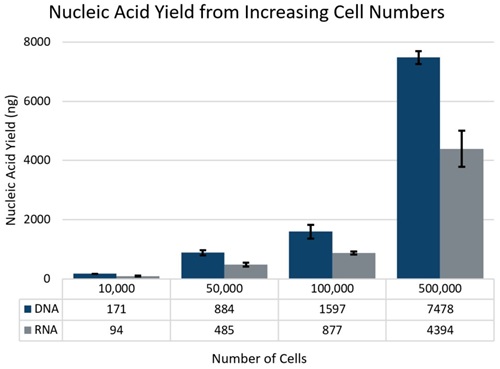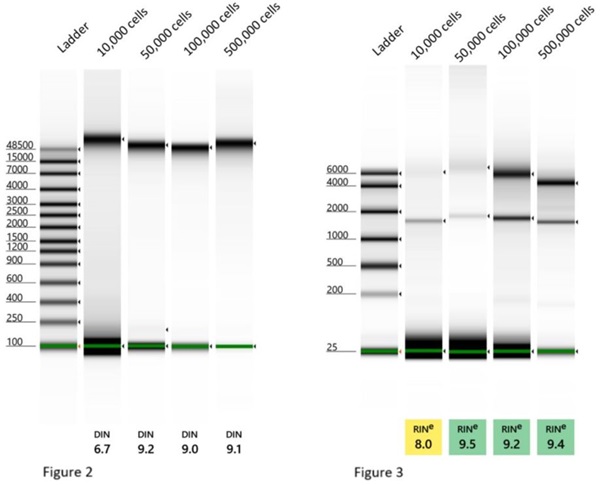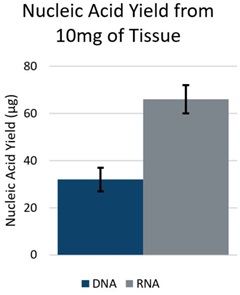DNA and RNA Isolation from Cells or Tissues
With the advance of Next Generation Sequencing (NGS), researchers now can access both genomic and transcriptomic data from a single sample. The ability to isolate high-quality DNA and RNA from a single biological sample is becoming increasingly important, especially when the sample yields small amounts of total nucleic acids. PoP team members have developed a protocol using Beckman Coulter reagents to isolate both DNA and RNA from the same cultured cell sample and tissue samples. The method utilizes a proprietary buffer to selectively bind RNA and DNA and eliminating the need to split a lysate before binding and washing the nucleic acid sample.
Protocols:
Simultaneous DNA and RNA extraction from cultured cells without splitting lysate
Simultaneous DNA and RNA extraction from tissue without splitting lysate
DNA Extraction from Human T Lymphocyte Cells
DNA and RNA was extracted from increasing cell numbers of Human T lymphocyte (Jurkat) cells: 10,000, 50,000, 100,000 and 500,000. DNA and RNA yield was measured by Quant-iT™ PicoGreen® dsDNA Assay and RiboGreen® RNA Assay (Thermo Fisher Scientific) (Figure 1). The average yield was 171 ng of DNA and 94 ng RNA for 10,000 cells; the average yield was 7µg of DNA and 4 µg of RNA for 500,000 cells. Both DNA and RNA yield increased in a cell number-dependent manner (Figure 1).

Figure 1
High integrity nucleic acid was obtained by using this protocol as assessed on an Agilent TapeScreen assay: DIN scores above 9.0 and RIN scores above 9.2 (Figure 2 and Figure 3). The RNA and DNA extracted from 10,000 cells showed a lower nucleic acid integrity (DIN 6.7 and RIN 8.0) due to the concentration of nucleic acid being below the quantitation range of the ScreenTape assay.

DNA Extraction from Frozen Mouse Liver Tissue
DNA and RNA was extracted from frozen mouse liver tisues. The yield of DNA and RNA was measured by Quant-iT™ PicoGreen® dsDNA Assay and RiboGreen® RNA Assay (Thermo Fisher Scientific) (Figure 1). From this experiment, the average yield from 10 mg mouse liver tissue of DNA was 32 µg and RNA 66 µg (Figure 4).

Figure 4
The integrity of the nucleic acids were assessed on an Agilent TapeScreen assay. The resulting DIN scores and RIN scores indicate highly intact DNA and RNA: DIN 9.2 and RIN 7.4 (Figure 5 and Figure 6).

